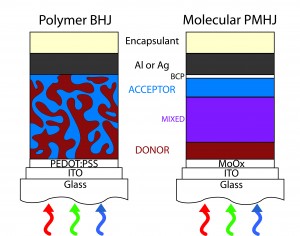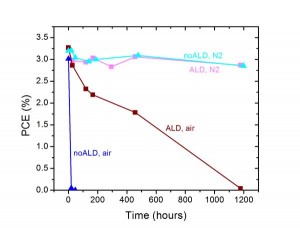Nano-thin Encapsulation of Photovoltaics via Atomic Layer Deposition
- Category: Energy, Nanotechnology
- Tags: jill macko, vladimir bulovic
Device lifetime is a key figure of merit for solar cells and impacts the levelized energy cost ( $/(kW*hr) ) of a photovoltaic module[1]. Its importance necessitates the encapsulation of solar cells; however, the prevalent commercial encapsulation (polymer thin film plus glass sheet) is inflexible and heavy, thereby increasing the installation and balance-of-systems costs. In this work we implement a nano-thin metal oxide film deposited by atomic layer deposition (ALD) as an encapsulation layer for organic photovoltaics[2]. With ALD we deposit a 27-nm nano-thin film of alternating layers of HfOx and AlOx[3] directly on top of the cathode of photovoltaics composed of either polymer bulk heterojunction or molecular planar-mixed heterojunction photoactive layers (Figure 1). The effect of the ALD process on the device performance and furthermore the dependence of lifetime on photoactive materials choice selection and cathode composition are examined. While the absolute lifetime of the devices depends on the composition of the photoactive film as well as the cathode, all devices displayed significant increases in lifetime when encapsulated with ALD nano-thin films versus no encapsulation. Molecular OPVs with Al electrodes and ALD nano-thin encapsulant exhibit less than 10% decay in efficiency over 1200 hours storage in air. As shown in Figure 2, aAddition of ALD nano-thin encapsulant to polymer PVs with Al electrodes increases device lifetime by up to 5,000%.
- Figure 1: Schematics of the device architectures studied in this work: polymer bulk heterojunction and small molecular planar-mixed heterojunction. The devices were fabricated with either Ag or Al electrodes and with or without the ALD nano-thin encapsulant.
- Figure 2: Effect of ALD encapsulation on time-resolved power conversion efficiency of polymer cells stored in air or in an inert environment. The cells last <1 day when exposed to air without encapsulation but maintain power generation after up to 1200 hours in storage with implementation of ALD nano-thin encapsulant.
- R. R. Lunt, T. P. Osedach, P. R. Brown, J. A. Rowehl, and V. Bulović, “Practical Roadmap and Limits to Nanostructured Photovoltaics,” Advanced Materials, vol. 23, no. 48, pp. 5712–5727, Nov. 2011. [↩]
- A. Bernardi, J. A. Rowehl, R. Po, A. O’Mahony, P. Scudo, and V. Bulovic, “Encapsulation of Organic Solar Cells with ALD deposited HfOx/AlOx films,” presented at International Conference on Science and Technology of Synthetic Metals, July 2012. [↩]
- C.-Y. Chang and F.-Y. Tsai, “Efficient and air-stable plastics-based polymer solar cells enabled by atomic layer deposition,” Journal of Materials Chemistry, vol. 21, no. 15, p. 5710, 2011. [↩]

